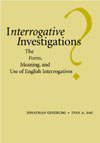

|
|
|
|

Interrogative InvestigationsThe Form, Meaning and Use of English Interrogatives Interrogative constructions are the linguistic forms by which questions are expressed. Their analysis is of great interest to linguists, as well as to computer scientists, human-computer interface designers, and philosophers. Interrogative constructions have played a central role in the development of modern syntactic theory. Nonetheless, to date most syntactic work has taken place quite separately from formal semantic and pragmatic work on interrogatives. Although there has by now been a significant amount of work on interrogatives across a variety of languages, there exist few syntactic and semantic treatments that provide a comprehensive account of a wide range of interrogative constructions and uses in a single language. This book closes the gap in research on this subject. By developing the frameworks of Head Driven Phrase Structure Grammar and Situation Semantics, the authors provide an account that rigorously integrates syntactic, semantic, and contextual dimensions of interrogatives. The challenge of providing exhaustive coverage of the interrogative constructions of English, including various constructions that occur solely in dialogue interaction, leads to new insights about a variety of contentious theoretical issues. These include matters of semantic ontology, the quantificational status of wh-phrases, the semantic effect of wh-fronting, the status of constructions in grammatical theory, the integration of illocutionary information in the grammar, and the nature of ellipsis resolution in dialogue. The account is stated with sufficient rigor to enable fairly direct computational implementation. Advance Praise for Interrogative Investigations
was lecturer in the computer science department at King's College, London and is now Professor, UFR Études anglophones Université Paris-Diderot (Paris 7). (1949–2013) was Professor of Linguistics at Stanford University. List of corrigenda. Read an excerpt from this book. Contents
4/1/2001 ISBN (Paperback): 1575862786 (9781575862781)
Books by Ivan A. Sag
|
Distributed by the
University of Chicago Press |
|
pubs @ csli.stanford.edu
|
CSLI Publications
Stanford University Cordura Hall 210 Panama Street Stanford, CA 94305-4101 (650) 723-1839 |